How much space is required to raise chickens in your backyard? This is a super common question for people new to raising chickens. To be honest, I was way off in understanding how much space would be required before I got my chickens, particularly how much of my yard they would take over.
In general, chickens should have between 3 to 4 square feet per chicken in a coop. If the chickens will be spending significant amount of time in the coop (e.g. in winter), then 5 square feet per chicken is recommended. Typically, chickens should have between 8 to 10 square feet per chicken in a run.
Keep reading to find out more about space requirements for chickens and the benefits and drawbacks to providing more space.
Space Needed for Chicks in Brooder
There is a wide range for how much space is recommended for chicks in a brooder. The brooder will be their temporary housing while they are small and have down feathers. After about 6 weeks, when they are more able to regulate their temperature and have real feathers, they can be transitioned to the coop.
On the low end, some people recommend that chicks need about 6 square inches per chick in a brooder. If you have 10 chicks, they will need about 60 square inches for their brooder. As a guide, this would be about 6 inches by 10 inches (slightly smaller than a sheet of printer paper).
On the higher end, others recommend that chicks should have about 2 square feet per chick in a brooder. For 10 chicks, this would be 20 square feet and would measure 4 feet by 5 feet.
For our 10 chickens, we chose a brooder size that was in between these two ranges. We had a cardboard box that was about 2 feet by 2 feet. This worked out fine for the first few weeks while the chicks were small. As they started to get real feathers, they were starting to run out of room and would get bored. I would hear them pecking on the thermometer in the brooder and one even jumped out.

Keep in mind that you will need to store their feeder and waterer in the brooder. If you choose to get a brooder sized on the low end, add in the amount of the space for the food and water so that the chicks will still have enough room to stretch, scratch, sleep, and walk.
Space Needed for Chickens in Coop
In general, you should provide at least 3 square feet per chicken in a chicken coop. This means if you have 10 chickens, you should have a minimum of 30 square feet for the coop. As a guide, this could be a coop that measures 5 feet by 6 feet.
When I measure a coop to determine the space, I will just take a measurement of the floor space. Even though the chickens will not necessarily spend time under the roosting bars (because that area is usually full of droppings), they will be on the roosting bars above and this space needs to be included in the overall measurement.
Some people will include the nesting boxes in the measurement, but since the nesting boxes on each of my coops have stuck out from the coop, I do not include them in the overall total for square footage. Each nesting box should be roughly 1 foot by 1 foot by 1 foot and you should have one nesting box per 4 to 5 chickens. My current coop has 5 nesting boxes for 10 chickens, which is plenty, but they all seem to prefer one box.
If you live in a climate that has long or very cold winters, you might want to consider more space for the inside of the chicken coop. If chickens spend a significant amount of time in a coop, like in winter, it’s recommended to have at least 5 square feet per chicken.
By comparison, factory chickens have 1 square feet per chicken and they are expected to live, sleep, and lay eggs in that space. You are treating your backyard chickens better than factory chickens, though, so provide them with as much space as you can using 3 to 4 square feet per chicken as a guideline.
Space Needed for Chickens in Run
Typically, chickens should have between 8 to 10 square feet per chicken if they will be spending time in a run during the day (instead of free ranging). This means if you have 10 chickens, you should have a minimum of 100 square feet for the run. As a guide, this could be a run that measures 5 feet by 20 feet.
There are several reasons why more space is recommended for the run compared to the coop. Chickens will typically only roost or lay eggs in their coop; therefore, the space required for these activities is less. Their food should be in the run, except during inclement weather where it will stay dry inside the coop or during frigid cold weather when the chickens are more comfortably warm inside the coop.
We started out with a run that measured 100 square feet for our 10 chickens. During the summer, we expanded this run, which doubled the size. The chickens needed more shade and I set-up a kiddie pool in the expanded run for them to dip their feet on really hot days. I can tell you that they prefer having more space to run around and I think we will keep this expanded run set-up for good.
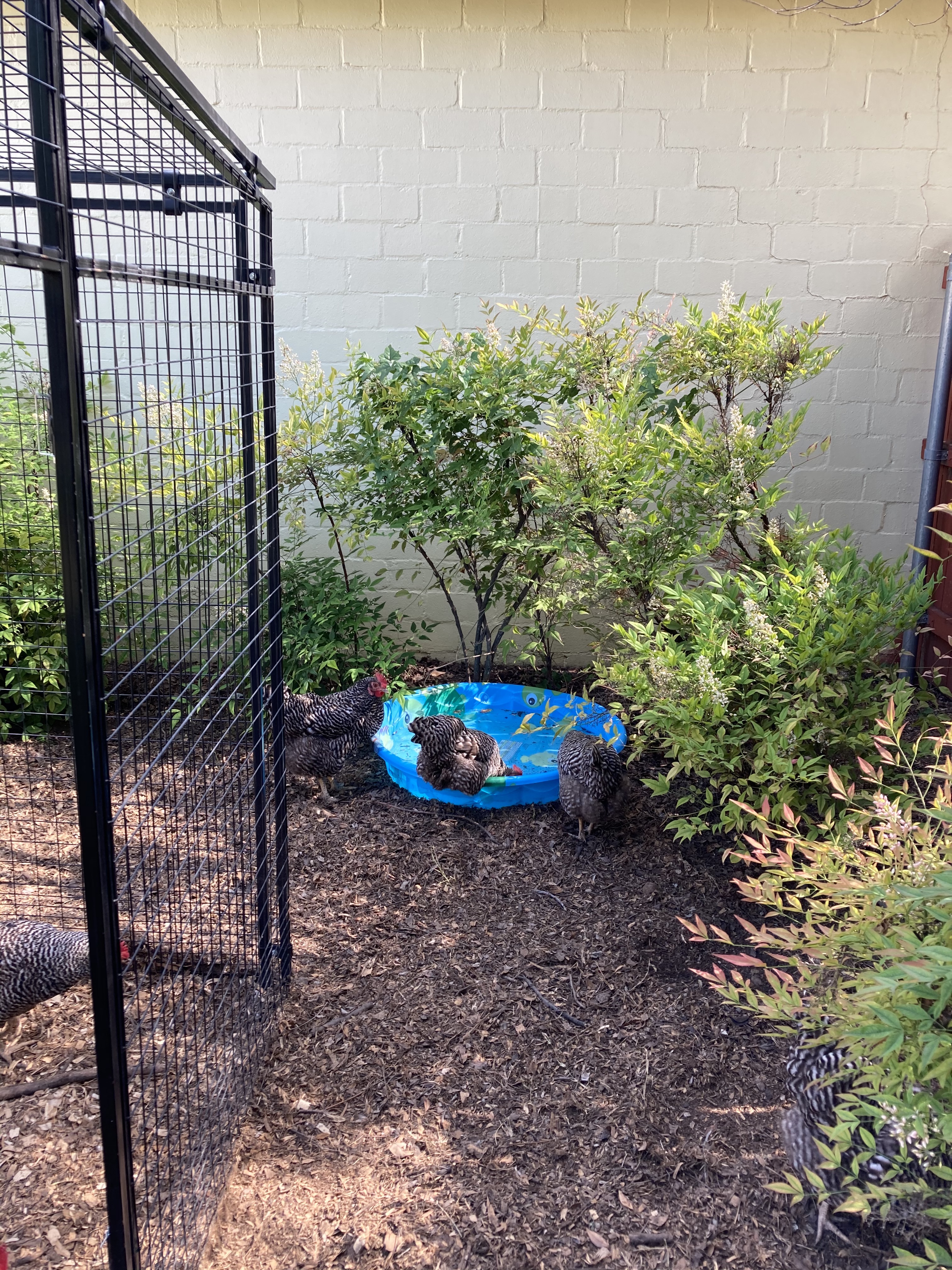
The run is where chickens have space to move around, stretch, scratch the ground, and dust bathe. These chicken activities require space! Don’t plan on keeping your chickens in their coop full-time. Take into consideration that they will need room to roam outside of the coop. This is something that I didn’t fully consider before we got our chickens, so I didn’t have a plan for a run initially (we eventually got a run, but it was after they destroyed our yard).
Yard Size for Free Ranging
There are a few things to consider if you decide to let your chickens free range in your yard. For most people, their yards will meet the minimum space requirements for a chicken run. If you let your chickens have free range of the entire backyard, understand that they will destroy your lawn, garden, and flower beds within a few weeks (or months if you have a particularly large yard).
Chickens will naturally scratch the ground, looking for seeds and bugs to eat. This scratching helps to aerate the soil, but will kill plants if it is done continually.
At our previous house, we had a quarter acre lot with the backyard taking up about a tenth of an acre. The chickens were allowed to free range all day and within a few weeks there were bare spots in the yard where they would dust bathe. After a few months, there was no grass, poop everywhere, and all my decorative plants had either been eaten or crushed.
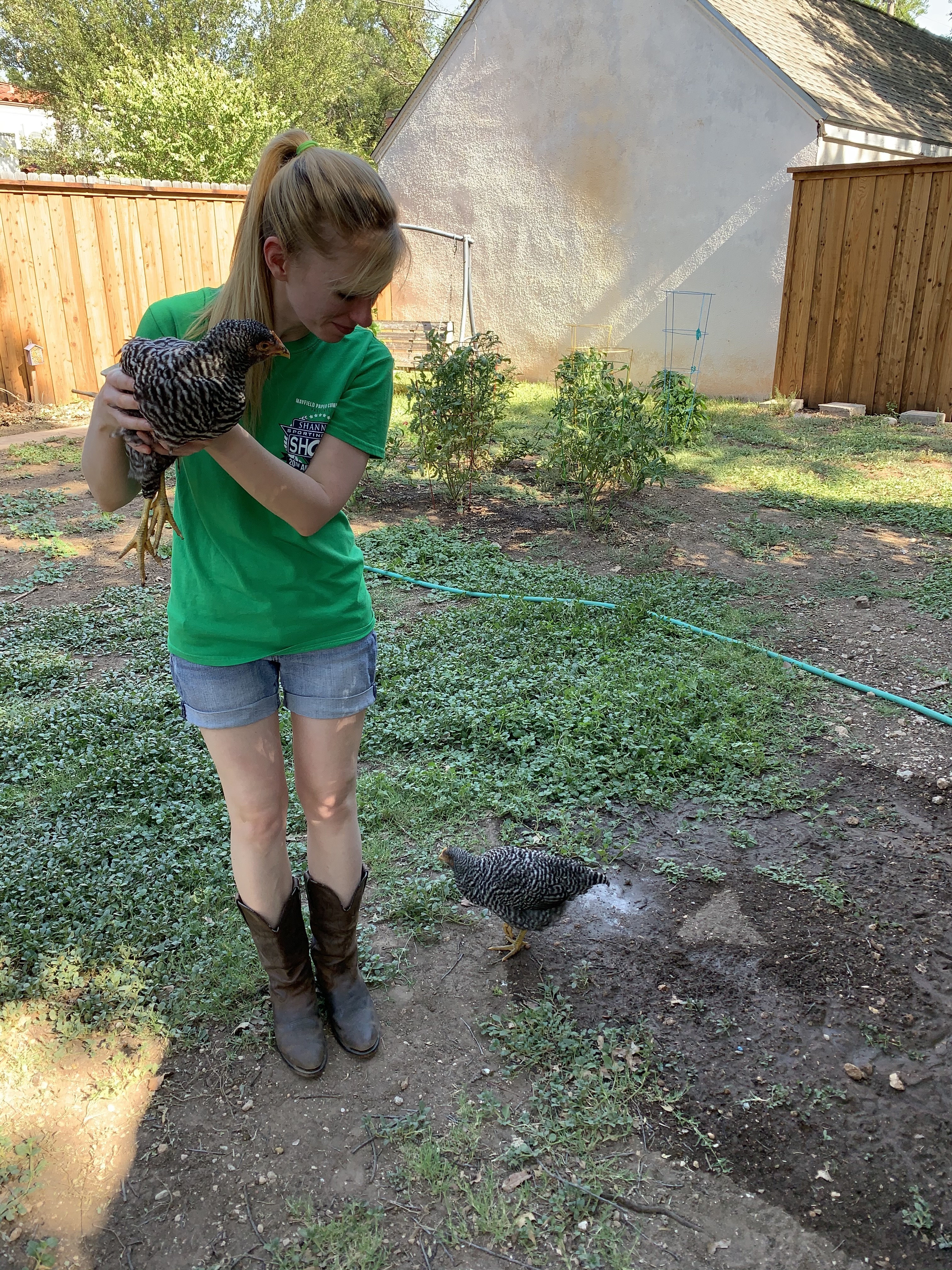
When we moved to our current house on half an acre, the backyard takes up a little less than a quarter of an acre. We will let the chickens free range, under supervision, in the evenings after work and on some weekends. They are not allowed on the porch or in the garden and our yard looks great (with the exception of the dry grass since we live in West Texas, it’s the summer, and we are in a perpetual drought).
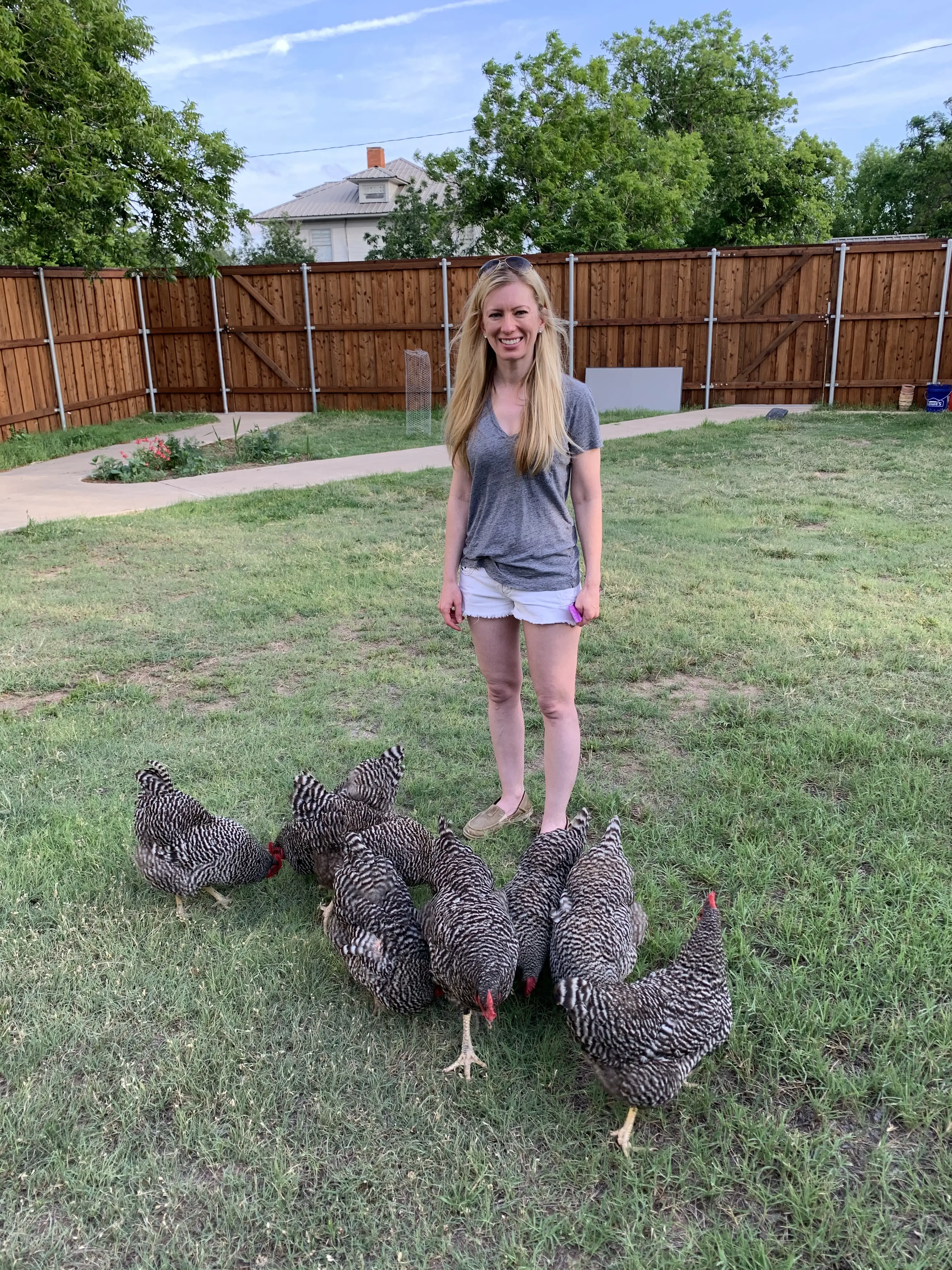
You might consider putting up fencing, either temporary or permanent, to keep the chickens in a particular area of your yard. I know of some people who will rotate their chickens to different parts of the yard after about a week or two to prevent that particular area from becoming a grassless, hard dirt plot scattered with mounds of chicken poop. Just make sure that if you fence in your chickens, that they still have access to their coop (or temporary nesting boxes), food, water, and shade.
Benefits and Drawbacks to Providing More Space
Over the past several thousand years, chickens have been domesticated from their jungle fowl cousins that slept in trees at night to the friendly chickens we know today. During that domestication, they have been bred to require less space in order to live alongside humans. However, chickens still require an adequate amount of space in order to have optimal health and good behavior.
Benefits of More Space
If you are able to provide the maximum space recommended for your chickens, there will be several benefits. First, more space means less bullying and aggression towards the more submissive chickens in your flock. When chickens are confined, they can become aggressive with each other, preventing other chickens from gaining access to food and water, and in extreme instances this aggression can lead to cannibalism. Cannibalism comes in several forms, included picking feathers, picking at skin or open wounds, and in very extreme cases killing another chicken.
Another benefit of providing more space for your chickens is there will be less manure build-up in a small area. Chickens produce a lot of manure and if this is not properly managed it can lead to illness to the chickens’ sensitive respiratory systems (from the ammonia smell, sometimes referred to as “ammonia burn”) and increased fly population that can transmit worms. Chicken coops that are overcrowded suffer from too much manure and not enough bedding to mix in with the manure. This leads to many issues that are better if they can be avoided altogether.
When chickens have more space to move around and get out energy, they are less likely to suffer from boredom. Boredom can lead to behavioral issues, like cannibalism, excessing squawking, overeating, and finding ways to escape the run. If you provide enrichment activities for your chickens they are less likely to become bored. We have a tree branch for the chickens to roost on, a stump, and a kiddie pool in our run to provide the chickens with things to interact with during the day. We will occasionally change out these items or move them around if we notice the chickens are being restless.
Chickens that are bored or bullied are more likely to be stressed. Stressed chickens suffer from poor sleep, lowered egg production, lack of energy, and eventually increased susceptibility of getting an illness or infection. When you can provide your flock with enough space to do chicken things, they will be more content and healthy.
Drawbacks of More Space
While there are many benefits to giving your chickens more space, there are a few drawbacks you should also take into account. As you give your chickens more space in the yard, you will have less yard. The space you dedicate to your chickens will not have a green lawn or pretty plants growing. Chickens can be destructive to your yard so if having a nice manicured lawn is important to you, just be aware that while chickens are awesome in many ways, they are tiny dinosaurs that will ruin your pretty plants.
By giving your chickens more space in your yard, you might decide that additional fencing will help to protect certain areas of your yard from destruction. Depending on the layout of your yard or any HOA rules, this might be challenging. Fencing can vary in cost depending on whether you do a basic t-post and chicken wire fence (like what we did for our extended run), or if you do something that looks nicer like a chain-link fence or use wood for the bracing or pickets.
When we doubled the size of the chicken run, there was a noticeable improvement in our chickens’ behavior. There was less random squawking during the day and the chickens were cleaner since they had room to dust bathe more frequently. If you are making the commitment to raise chickens, please provide them with enough space so they can live a happy, healthy life!

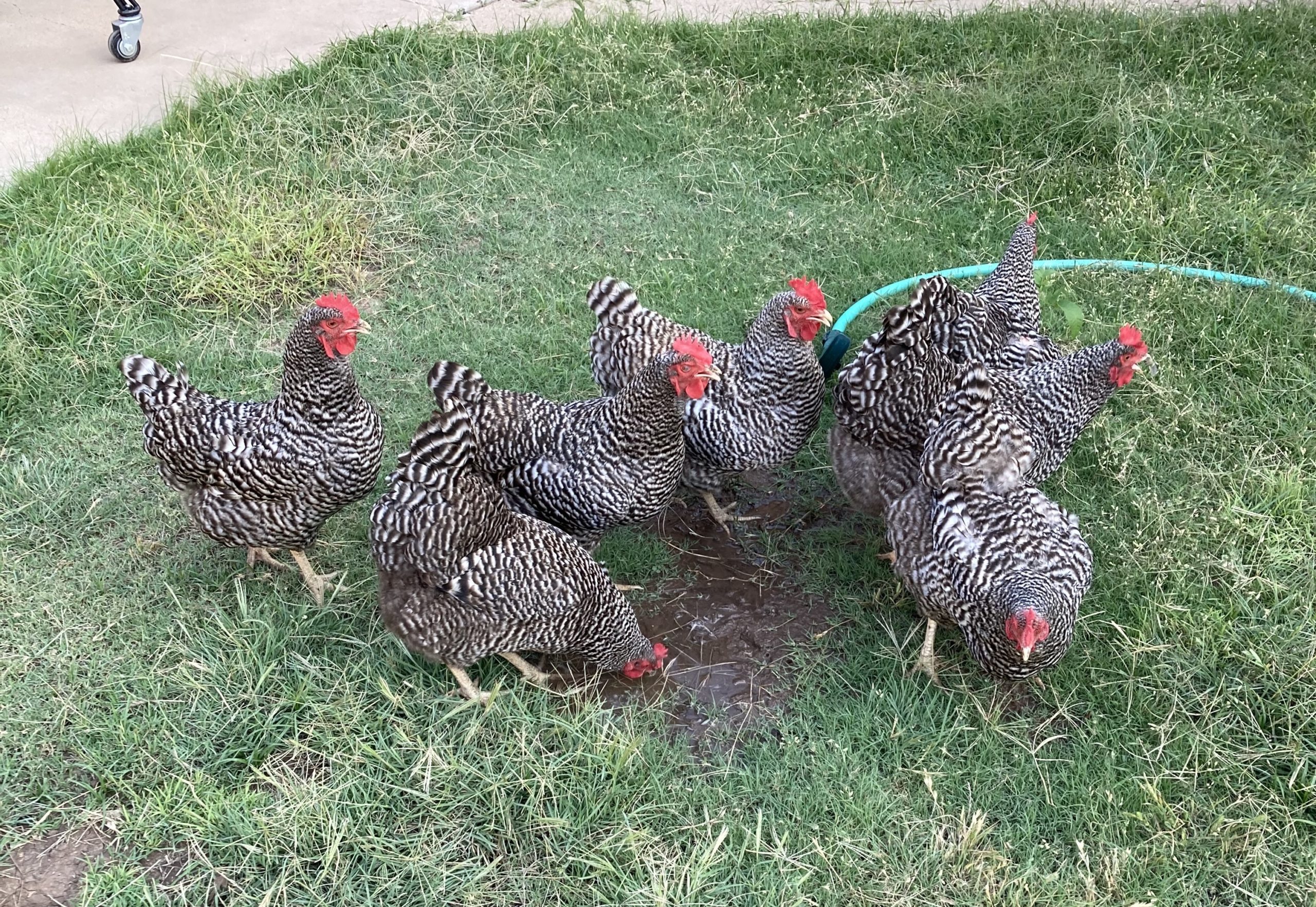
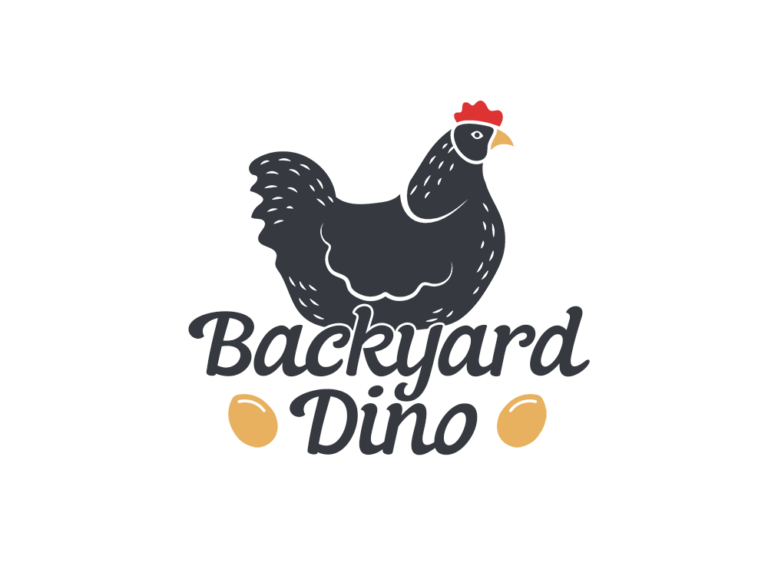
2 comments
[…] did a review of the OverEZ walk-in 16 foot run that we use for our chickens. I have also written a post about the space requirements for chickens, including inside their coop and run, and also the space […]
[…] this post, I have a section on the size requirements for a […]
Comments are closed.